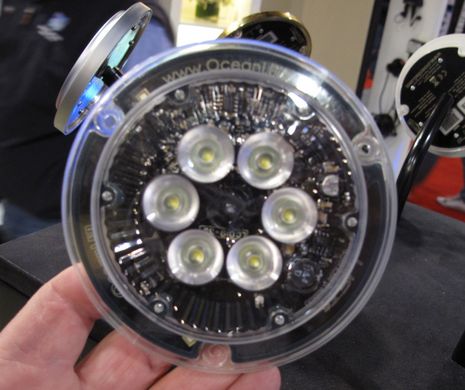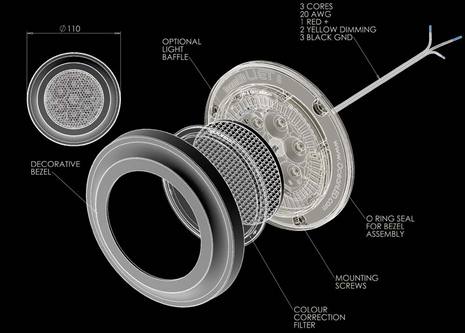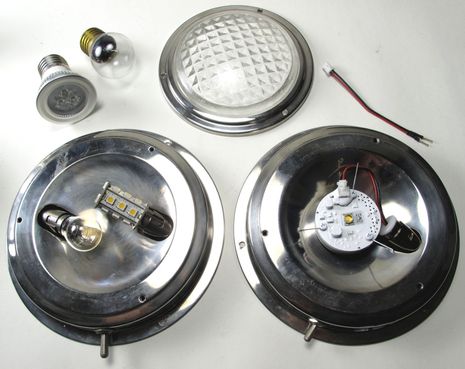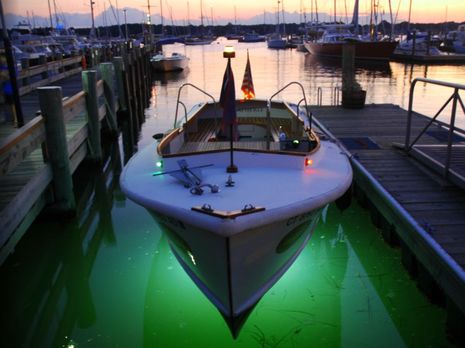OceanLED LIETs, simply extraordinary?
In Miami I got a good introduction to OceanLED’s new line of LIET LED down lighting fixtures, and was thoroughly intrigued. LIET (old English for “light” and pronounced the same way) seems to represent a significant technological leap. That LIET6 core above, for instance, is less than five inches in diameter and a half inch thick, but produces what’s claimed to be the equivalent of a 50w Halogen bulb while only using 5.3 watts of power. It even has built-in diagnostics and dimming. And while blindingly bright, it doesn’t get hot to finger touch even though it lacks a discernible heat sink. How did they do it?
For one thing, OceanLED has invested some 2.5 million pounds in R&D. For another, company founder Nigel Savage resides in my memory as one of the most passionate innovator entrepreneurs I’ve ever met, though that only happened once many years ago. I guess I shouldn’t be surprised that OceanLED not only seems to have achieved extraordinary power efficiency with LIET (65 lumens per watt!), but apparently also paid extraordinary attention to light quality and the ability to customize it to the particular boat area it might illuminate. There is an almost daunting variety of color temperature, lens, filter, baffle, and bezel options available. You can learn a lot about all this, and light science, on the LIET web pages, but don’t be too put off by the company’s big yacht orientation.
OceanLED takes an unabashedly high-end approach, but I think that LIET6s at $199 retail, or the new LIET3s (35w halogen equivalent) at $149, may make sense for some middle-end cruisers. In fact, I’m finally working on a spreadsheet of options for replacing Gizmo’s horridly inefficient dome and task lights, as mentioned last summer when I saw how well Imtra is replicating 20w halogens. I intend to test several of these options, and will have more on that project soon, but I certainly hope that I can get LIET’s claimed brightness, efficiency, and full spectrum quality to a couple of key areas like the galley and dining table.
















The problem I’ll have installing a LIET or two is that they are designed to be on a switched circuit. All of Gizmo’s lights are individually switched at the fixture, and it would be very hard to change that. I have some ideas about how to build a simple base with switch, but would love to include a compact, inexpensive 0-10v dimmer controller. Ideas anyone?
Ben,
A pulse width modulator (PWM) should work well as a DC dimmer. Use a 555 CMOS timer with a PMOS power Fet and variable resistor to vary the pulse witdh. The variable resisitor works with a capacitor and the 555 to create a variable pulsewidth to drive the Power NMOS fet. Basically, the longer the pulsewidth the brighter the light. Hope this helps.
Hi Ben,
The LIET lights look nice, but they are awefully expensive.
I’ve been using LED dome lights for two years on the 40′ steel trawler I’m building.
They work great, and draw next to no power 🙂 And they are cheap. CDN$ 30.95
They are 6.75″ in diameter, and have a built in toggle switch.
Here is the link to the catalog page. http://viewer.zmags.com/publication/f56f8ceb#/f56f8ceb/204
Thanks, Andreas. That’s an extraordinary price, but I’m pretty sure that it is the same fixture I already have with an LED replacement bulb of some sort. I am going to try that option, but will go with ‘bulbs’ that use the constant current design and make some claim as to lumens provided. One thing I’ve already learned is that LEDs are not a commodity; there’s a whole electronics system in each light, and they vary tremendously.
Thank you too, Mike, but LIETs don’t need PWM control, and, in fact, won’t work with it unless custom made to (according to the tech lit at the OceanLED site). Each LIET has a high frequency dimmer built in and only needs a 0-10v feed on the third wire to control it. So all I’m looking for is a simply knob or slide controller that can smoothly convert 12v to a 0-10 signal that will dim the light from nothing to full brightness. I understand that there are even small wireless modules that could do this for several lights at a time, which would be neat, but I can’t find ones for 12 volts.
Ben, I don’t have any experience with dimmers, but I came across this product on a web-site today that might be what your looking for:
Manual here:
http://www.mastproducts.com/index.php?ID=53
Catalog here (model DR05050505), 12v/DC to 12v/DC Dimmer.
http://www.mastproducts.com/index.php?ID=49
I see it for sale on the euro marine trading web site.
It would be best if anyone selling LED products would make it crystal clear up front how many lumens their product provides and an assurance that they don’t generate RFI interference that could effect our VHF radios, TV’s etc. on our boats. It’s not good enough to tell me 50,000 hours and 3 watts power consumption. Lumens are not familiar to most of us and comparisons to other types of bulbs would seem useful … but having been dissapointed with home LED products that claim “equal to a 60 watt bulb” and fall very far short, a claim of Lumens is necessary for me to even look at a product as is a claim of no RFI interference.
1) That said, anyone seen a replacement LED bulb replacement for a 20 watt outside halogen boat fixture (like a Forspar ML-1 spreader light, that actually lived up to the claim ?
2) I see some LED spreader mounted deck lights advertised, but they all seem to have very simple mounts, that on a sailboat wouldn’t survive being battered by a sail or is designed to prevent a halyard from getting wrapped around it. Anyone seen something suitable for a sailboat mast to illuminate a deck ?
I have yet to see anything that compare with the Sensibulb… So far every single LED module I’ve found is vastly inferior. We have three of these in the salon, and they are great.
You can see how I converted some outdoor 110VAC lights into dual voltage lights with Sensibulb modules here:
http://www.svjaneo.com/2010/01/diy-dual-voltage-lighting.html
I base my experience after being continually disappointed at every single other LED module… And I’m not alone!
Note: I’m talking about INSIDE lights… I have not idea about OUTSIDE LED lights…
Dan,
Take a look at the Marinebeam.com Solo Vision spreader lights: http://www.marinebeam.com/soviledspla.html
I used them to replace the normal sealed beam Perko lights that were there. Mounted on the spreaders, they made the offshore trip from the Chesapeake Bay direct to Andros Island, The Bahamas. We went through 18-20ft waves in 40+ kts for 23 hrs. I tore up the jib, and broke 4 slides between my main and mizzen (all down on 2nd reef). Point being the lights fared better than the sails, and they were much brighter than the perko’s EVER were. And they use almost no power by comparison. To be fair, they are mounted halfway to the shrouds, so mostly out of harms way. They are mounted on a single bolt, I had to put nylon spacers in to allow me to point them down at the correct angle (almost straight down). They really are NICE AND BRIGHT!
Bob
Dan, While I think MarineBeam looks like an excellent LED source, you might also consider the Lumitec Caprera I tried last season:
https://panbo.com/archives/2009/09/oceanled_lumitec_better_spreader_lights.html
As for my LIET setup, I guess I haven’t been clear. I don’t need a dimmer; each LIET has a dimmer already built in. I’m just looking for the dimmer control, which simply delivers a 0-10v signal. 10v makes the LIET full brightness, 5v tells its internal dimmer to go to half brightness, etc. etc. It doesn’t have to carry much current at all, but it does have to make 0-10 volts from 12 volts.
Hi Ben,
Greetings from Boqueron, PR.
It’s a pity LIET requires a 10-volt signal to drive its dimmer — it would be so much simpler if it were 12 VDC. All you’d need is a pot with a knob. Probably that would work anyway, maybe need a series resistor to get the voltage down to 10. Size depends on the current draw, of course.
And I wish that manufacturers would make these units in 24 volts as well as 12!
Ben,
Didn’t know about the built-in dimmer voltage. A very easy way to generate the needed 0-10v from 12v is a potentiometer and series resistor. For example: Use a 10K ohm pot with a series of 2K ohms to the +12v. One end of the pot is ground, the other end goes to the 2K resistor (other resistor end to +12v), the wiper goes to the LED dimmer. If the LED can not handle anything above 10v on the dimmer control input, place a shunt 10v zener diode from the pot 2K resistor junction to ground.
If you need more current from the pot for dimmer control just scale the resistor and pot values down, example 200 ohms and 1K respectively. Scale up for less current. Hope this helps.
Michael, LIETs can operate on 12 or 24 volt feeds (min 10, max 35) because like most quality LEDs they contain their own DC-to-DC constant current converters. They use 0-10v dimmer control because it’s a standard:
http://en.wikipedia.org/wiki/0-10_V_lighting_control
Ben, Thanks for sharing this info on the evolution of LED lighting. I echo Scott E’s comments on the Sensibulb – the light quality is excellent, and at $33 in bulk (I bought 12) it’s hard to argue their value. On the other hand, they definitely do not output at a 50W, or even 35W halogen level, so are designed for a different purpose. The LIET price point and features definitely point towards an upscale market, but I look forward to their investment in technology being brought downstream at some point. By the way – this link might be almost a couple of years old, but it’s a great post comparing the LED light quality of a variety of different lower end companies – http://www.sailnet.com/forums/gear-maintenance/49026-led-bulb-comparison.html
Ben,
We used Vimar dimmers on our overhead LED lights. Here’s a link to the US distributor http://www.drsa.com/index.html
Mike
After some more thought, even if the right product for 0-10 volts is found, I can see how adding a dimmer is going to be very problematic. Cutting up the interior of our boats to install extra controls and wiring is never easy, but with lighting that is especially challenging.
Considering all the electronics that are already in these bulbs, for example to do DC to DC conversion to accept voltages from 10 to 32 volts, may I suggest a solution to all the LED bulb providers as an alternative to dimming switches ?
1. Integrate a small LED sized sensor on the bulb surface such as those used by TV remotes.
2. Allow for a battery operated remote control to control the dimming.
3. Include remote functionality to allow us
(a) to set two or three dimming levels per bulb, by getting the remote relatively close up to the bulb, pointing the remote at it, and increasing or decreasing the dimming level one bulb at a time. Call this DIM 1 and DIM 2.
(b) From one button on the remote allow us to choose dimming level 1, all the way down to off.
(c) From a second button on the remote allow us to choose dimming level 2
(d) From a third button on the remote allow us to choose full brightness
(e) From a fourth button on the remote allow us to choose a quick and temporary “off”
(f) Important: Needed dedicated buttons. For (b) thru (e) above, it should not matter how many times the bulb receives the command. E.g. If I have 10 bulbs in my saloon, and I have to point my remote in two or three general directions to cover all the bulbs in the room to dim to level 2, the few bulbs that receive the command twice should act no different than those that receive it once.
(g) Each time the bulb is switched off and back on at the power source (our DC breaker) default to dimmer level 1.
(h) Each time the bulb is switched off and back on at the power source in rapid succession (twice in one second), default to full brightness. Don’t be fooled by a power spike such as an engine start.
Dare I suggest a standard is created, so the same remote control handles all vendors interior lighting bulbs ?
You can suggest all you want, Dan, but don’t expect much 😉 I like the idea of wireless LED switching/dimming a lot, and I’ve heard a vendor or two mention the possibility, but I don’t know of any actual systems out there. In fact, there seem to be numerous ‘standards’ for wired LED dimming, and I’ve yet to find a good information source about them. Here’s a hint of complications:
http://www.sailorsams.com/mall/led_dimmers.asp
A much better idea (have you seen the super cheap price of a sufrace mount bluetooth chip !!).
Add bluetooth receivers to each bulb so that Apple, Blackberry, and Android applications can be the remote control allowing the lights to be selected and/or dimmed together or seperatly without aiming, for a PC to be used instead, and/or …
Ben,
We used VIMAR low voltage dimmers on our LEDs. They work great. Check out http://www.drsa.com/ for details.
Mike
Mike, I’m not looking for a dimmer, just a dimmer controller.
Ben,
I can design a small 10V constant voltage source for you, NP. What I’d need to know is what the input impedance of the LIET leds is. Given that I can tell you what resistance the poti or slider should be, and give you the design for the voltage source. If the impedance is high (= the input does not consume power) we can use a simpler circuit.
Mike Wyatt is on the right track, but if you don’t use some electronics to regulate the 12V source to a constant 10V then the lights will dim/brighten with the voltage variations coming out of your battery.
Is that helpful? Can you solder a simple 2-3 part circuit if I give you instructions?
Kees
Ben,
Maybe I’m confused but the VIMAR system is a card deck sized controller and a separate switch.
Mike
Thanks, Kees; that’s a kind offer. I hope to talk to the tech people at OceanLED and I’ll ask about the input impedance. But I’m hoping they can also steer me to a simple 0-10v controller that’s already made up. Having me as circuit board student might ruin our good relationship 😉
Mike, you are confused but it’s largely my fault. I keep saying that the LIETs have built-in dimmers and that I’m just looking for a controller, but I forget that dimmers are often called dimmer controllers. So what I’m looking for more precisely is a dimmer controller controller!
A couple of comments for Dan.
Be careful of Lumen claims from LED vendors. I am in the marine LED lighting business, and have a goniophotometer here that allows me to test competitive products for luminous flux (lumens). I am also actively working with stakeholders of the DOE Energy Star standards for measuring solid-state lighting, and I can tell you this: Virtually everyone in the marine lighting business is falsifying their lumen claims. Even the best known vendor mentioned above is off on their lumen claims by more than 50%. This is because these vendors use the LED spec sheet values for lumens per die, and multiply that by the number of LED dies, and then claim that as lumens. Unfortunately it doesn’t work that way. By the time you package them into a useful form factor, then consider thermal efficiency, thermal conductivity, and junction temperature thresholds, you have a much different, and significantly lower outcome.
You mention the certain company that is making a claim of “60 watt equivalency” with their 3W bulb. To illustrate how far-fetched that is, that would be more than 200 lumens per watt! Given that, this guy could waltz on down to the DOE and claim the $10 million L-Prize. I suspect they make this claim because most people don’t know the difference between luminous flux (lumens) and lumen density (lux). Apples and Oranges.
Here is how to smoke them out: Look at wattage. We use the very best surface mount LEDs available from CREE, SSC, Citizen and Nichia, and the best efficacy (lumens/watt) we can generate in warm white (on our highest end products) is about 70 lumens per watt. The vast majority of competitive products using SMD’s that we test are between 30 and 50 lumens/watt. Parallel leg LEDs can be even lower. Interestingly, one of the bulbs with the largest following has an efficacy of 40 lumens/watt. Cool White LEDs have a better efficacy than warm white.
So, forget about the claims, and look at wattage. Engage the proprietor, and see if he understands lighting and LEDs. Ask him about efficacy. Better yet, ask him the difference between efficacy and efficiency! If he seems knowledgable, take his warm white bulb’s LED wattage and multiply by 45 or 50. That will give you a sense of where you are in effective lumens. Lumens are the total light energy emitted from the bulb, and does not consider direction or distance. If someone claims 100 lumens at 20 feet they don’t know what they are talking about. Think of a lumen as a watt that has been corrected for the spectrum of energy that the eye can see, because that is indeed what luminous flux is!
For RFI, look for vendors that meet the CE directive for EMC (electro-magnetic compatibility). Bulbs with the CE mark have been tested for emmissions and immunity to the EN (european) norms. All good LED products with current-control over a voltage range (needed on a boat)generate some EMI, but with the CE mark, you know they are below thresholds set by the industry.
Lastly, there won’t be a replacement bulb for your masthead deck light anytime soon. This is because LED lighting is a balance between form factor, thermal management (life), and light output. To make a 20W equivalent the size of your tiny halogen makes it a serious challenge. We can make the light, but can’t remove the heat. If we can remove the heat (with heatsinks), we can no longer make it fit your legacy fixture. Etc.
Thanks for commenting, Jeff. You’re helping us all better understand this complicated technology. In fact, I think your site, http://www.marinebeam.com/ is one of the most informative on this subject, and I hope to try one or more of your products (I’ll continue that conversation by e-mail).
But I do think that if you’re going to level fairly harsh charges at competitors, you may as well name names so they have a chance to respond:
“Virtually everyone in the marine lighting business is falsifying their lumen claims. Even the best known vendor mentioned above is off on their lumen claims by more than 50%.”
Do you mean OceanLED or Imtra? Could this be more a matter of definition than ‘falsifying’?
I notice that the LIET efficacy claim of 65 lumens per watt is in line with your own best case of 70. LIETs also have CE approval incidentally.
Thank you Jeff, this is very helpful.
Fair point Ben. To be clear, I wasn’t referring to either IMTRA or OceanLED, both great and knowledgeable companies. I don’t know LIET, but wasn’t referring to them either. I was addressing Dan’s specific post only, as prefaced in my comments. I may have strayed off course in order to illustrate my point in response to Dan’s suggestion that comparing lumens was what was needed. I don’t want to name names and start a flame, because my goal is to educate, not impugn. I will stand behind my statements, and specifically in response to Dan’s comment about the certain very well known company that is claiming 60W equivalency from a 3W bulb. It is an absurd claim, and blatantly misleading IMHO, but the general public can still fall for it.
For the record, I know IMTRA very well, and they have an outside lab that is very well respected that does their testing to industry standards. I know this, because I have used some of their lamps and the associated photometry data to validate my photometry equipment. Their sales guys and lighting products team is VERY knowledgeable regarding LED lighting, and I chat with them from time to time. Their LED white papers on their website are fantastic.
The industry has a standard, LM-79, which designates how to test for luminous flux. It can’t be done with a simple light meter. It is either done with a goniophotometer, then cosine corrected and integrated mathematically, or done with an integrating sphere. Both expensive and complex methods.
BTW, did you know there is also an industry standard for lifespan? The industry standard, L70, for LED Lifespan isn’t referring to when they blink out, but to when they have depreciated to 70% of their original brightness. So lifespan claims of 50,000 to 100,000 hours for high output LEDs are also misleading. Their L70 lifespan (what the mfr should be quoting) is likely significantly less.
Look for a Lighting Facts label to appear on solid state lighting soon. It will look just like the Nutrition Facts label on food. This is part of the new Energy Star standard which will be implemented soon. This is because the DOE agrees that there is a huge amount of misinformation out there. The fines for copying or falsifying this label will be huge.
I guess the best way to say it is that Lumen claims can be unreliable, misapplied, or arrived at simply from LED spec sheets. The best way for guys like Dan to evaluate the output, is to look at wattage, evaluate where on the technology curve the vendor is, and apply an efficacy factor to the wattage, then compare that way.
Cheers,
Jeff
Thanks, Jeff. I’m a big Imtra fan too. LIETs, incidentally, are made by OceanLED. Their 50,000 hour lifetime is specified and explained as L70. I think you’ll appreciate how specific and detailed the product info is:
http://www.oceanled.com/Product_Pages/LIET6.php
I already use OceanLED’s underwater lightsand they are definitely worth the money. They seem to be going the same direction with the LIET products: low profile, bright and efficient.
OTOH I got some cheap G4 style LEDs from Ebay in warm white that aren’t quite as bright as the halogens, but work fine for reading for about the sales tax or maybe less of these lights.